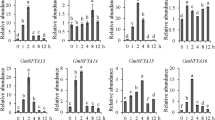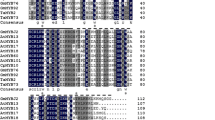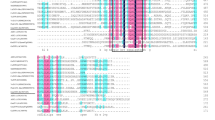Abstract
Nuclear factor Y (NF-Y) is a heterotrimeric transcription factor composed of NF-YA, NF-YB and NF-YC proteins. In this study, we identified and characterized a gene, GmNFYA3, which encodes the NF-YA subunit of the NF-Y complex in soybeans (Glycine max L.). Real time RT-PCR analysis indicated that GmNFYA3 was induced by abscisic acid (ABA) and abiotic stresses, such as polyethylene glycol, NaCl and cold. Subcellular localization analysis suggested that GmNFYA3 may activate its specific targets in the nucleus. Histochemical β-glucuronidase (GUS) staining revealed that the expression of the GUS gene driven by the GmNFYA3 promoter occurred in various transgenic Arabidopsis tissues. Coexpression in Nicotiana benthamiana and 5′ RACE assays indicated that miR169 directs GmNFYA3 mRNA cleavage in vivo. Overexpression of GmNFYA3 resulted in Arabidopsis with reduced leaf water loss and enhanced drought tolerance. In addition, the transgenic Arabidopsis exhibited increased sensitivity to high salinity and exogenous ABA. Moreover, the transcript levels of ABA biosynthesis (ABA1, ABA2), ABA signaling (ABI1, ABI2) and stress-responsive genes, including RD29A and CBF3, were generally higher in GmNFYA3 plants than in wild-type controls under normal conditions. These results suggest that the GmNFYA3 gene functions in positive modulation of drought stress tolerance and has potential applications in molecular breeding to enhance drought tolerance in crops.










Similar content being viewed by others
References
Aono M, Kubo A, Saji H, Tanaka K, Kondo N (1993) Enhanced tolerance to photooxidative stress of transgenic Nicotiana tabacum with high chloroplastic glutathione reductase activity. Plant Cell Physiol 34(1):129–135
Ben-Naim O, Eshed R, Parnis A, Teper-Bamnolker P, Shalit A, Coupland G, Samach A, Lifschitz E (2006) The CCAAT binding factor can mediate interactions between CONSTANS-like proteins and DNA. Plant J 46(3):462–476. doi:10.1111/j.1365-313X.2006.02706.x
Cao S, Kumimoto RW, Siriwardana CL, Risinger JR, Holt BF 3rd (2011) Identification and characterization of NF-Y transcription factor families in the monocot model plant Brachypodium distachyon. PLoS ONE 6(6):e21805. doi:10.1371/journal.pone.0021805
Chen NZ, Zhang XQ, Wei PC, Chen QJ, Ren F, Chen J, Wang XC (2007) AtHAP3b plays a crucial role in the regulation of flowering time in Arabidopsis during osmotic stress. J Biochem Mol Biol 40(6):1083–1089
Clough SJ, Bent AF (1998) Floral dip: a simplified method for Agrobacterium-mediated transformation of Arabidopsis thaliana. Plant J 16(6):735–743. doi:10.1046/j.1365-313x.1998.00343.x
Combier JP, Frugier F, de Billy F, Boualem A, El-Yahyaoui F, Moreau S, Vernie T, Ott T, Gamas P, Crespi M, Niebel A (2006) MtHAP2-1 is a key transcriptional regulator of symbiotic nodule development regulated by microRNA169 in Medicago truncatula. Genes Dev 20(22):3084–3088. doi:10.1101/gad.402806
Ding Z, Li S, An X, Liu X, Qin H, Wang D (2009) Transgenic expression of MYB15 confers enhanced sensitivity to abscisic acid and improved drought tolerance in Arabidopsis thaliana. J Genet Genomics 36(1):17–29. doi:10.1016/S1673-8527(09)60003-5
Finkelstein RR, Gampala SS, Rock CD (2002) Abscisic acid signaling in seeds and seedlings. Plant Cell 14(suppl):S15–S45. doi:10.1105/tpc.010441
Gao T, Wu Y, Zhang Y, Liu L, Ning Y, Wang D, Tong H, Chen S, Chu C, Xie Q (2011) OsSDIR1 overexpression greatly improves drought tolerance in transgenic rice. Plant Mol Biol 76(1–2):145–156. doi:10.1007/s11103-011-9775-z
Gusmaroli G, Tonelli C, Mantovani R (2002) Regulation of novel members of the Arabidopsis thaliana CCAAT-binding nuclear factor Y subunits. Gene 283(1–2):41–48
Haake V, Cook D, Riechmann JL, Pineda O, Thomashow MF, Zhang JZ (2002) Transcription factor CBF4 is a regulator of drought adaptation in Arabidopsis. Plant Physiol 130(2):639–648. doi:10.1104/pp.006478
Higo K, Ugawa Y, Iwamoto M, Korenaga T (1999) Plant cis-acting regulatory DNA elements (PLACE) database: 1999. Nucleic Acids Res 27(1):297–300
Hu H, Dai M, Yao J, Xiao B, Li X, Zhang Q, Xiong L (2006) Overexpressing a NAM, ATAF, and CUC (NAC) transcription factor enhances drought resistance and salt tolerance in rice. Proc Natl Acad Sci USA 103(35):12987–12992. doi:10.1073/pnas.0604882103
Huang XY, Chao DY, Gao JP, Zhu MZ, Shi M, Lin HX (2009) A previously unknown zinc finger protein, DST, regulates drought and salt tolerance in rice via stomatal aperture control. Genes Dev 23(15):1805–1817. doi:10.1101/gad.1812409
Ito Y, Katsura K, Maruyama K, Taji T, Kobayashi M, Seki M, Shinozaki K, Yamaguchi-Shinozaki K (2006) Functional analysis of rice DREB1/CBF-type transcription factors involved in cold-responsive gene expression in transgenic rice. Plant Cell Physiol 47(1):141–153. doi:10.1093/pcp/pci230
Jefferson R, Kavanagh T, Bevan M (1987) GUS fusions:ß-glucuronidase as a sensitive and versatile gene fusion marker in higher plants. EMBO J 6(13):3901–3907
Jones-Rhoades MW, Bartel DP (2004) Computational identification of plant microRNAs and their targets, including a stress-induced miRNA. Mol Cell 14(6):787–799. doi:10.1016/j.molcel.2004.05.027
Kang JY, Choi HI, Im MY, Kim SY (2002) Arabidopsis basic leucine zipper proteins that mediate stress-responsive abscisic acid signaling. Plant Cell 14(2):343–357. doi:10.1105/Tpc.010362
Kasuga M, Liu Q, Miura S, Yamaguchi-Shinozaki K, Shinozaki K (1999) Improving plant drought, salt, and freezing tolerance by gene transfer of a single stress-inducible transcription factor. Nat Biotechnol 17(3):287–291. doi:10.1038/7036
Ko JH, Yang SH, Han KH (2006) Upregulation of an Arabidopsis RING-H2 gene, XERICO, confers drought tolerance through increased abscisic acid biosynthesis. Plant J 47(3):343–355. doi:10.1111/j.1365-313X.2006.02782.x
Lee H, Fischer RL, Goldberg RB, Harada JJ (2003) Arabidopsis LEAFY COTYLEDON1 represents a functionally specialized subunit of the CCAAT binding transcription factor. Proc Natl Acad Sci USA 100(4):2152–2156. doi:10.1073/pnas.0437909100
Léon-Kloosterziel KM, Gil MA, Ruijs GJ, Jacobsen SE, Olszewski NE, Schwartz SH, Zeevaart JAD, Koornneef M (1996) Isolation and characterization of abscisic acid-deficient Arabidopsis mutants at two new loci. Plant J 10(4):655–661. doi:10.1046/j.1365-313X.1996.10040655.x
Li H, Sun J, Xu Y, Jiang H, Wu X, Li C (2007) The bHLH-type transcription factor AtAIB positively regulates ABA response in Arabidopsis. Plant Mol Biol 65(5):655–665. doi:10.1007/s11103-007-9230-3
Li WX, Oono Y, Zhu J, He XJ, Wu JM, Iida K, Lu XY, Cui X, Jin H, Zhu JK (2008) The Arabidopsis NFYA5 transcription factor is regulated transcriptionally and posttranscriptionally to promote drought resistance. Plant Cell 20(8):2238–2251. doi:10.1105/tpc.108.059444
Liang M, Hole D, Wu J, Blake T, Wu Y (2012) Expression and functional analysis of NUCLEAR FACTOR-Y, subunit B genes in barley. Planta 235(4):779–791. doi:10.1007/s00425-011-1539-0
Livak KJ, Schmittgen TD (2001) Analysis of relative gene expression data using real-time quantitative PCR and the 2(-Delta Delta C(T)) Method. Methods 25(4):402–408. doi:10.1006/meth.2001.1262
Llave C, Xie Z, Kasschau KD, Carrington JC (2002) Cleavage of Scarecrow-like mRNA targets directed by a class of Arabidopsis miRNA. Science 297(5589):2053–2056. doi:10.1126/science.1076311
Mantovani R (1999) The molecular biology of the CCAAT-binding factor NF-Y. Gene 239(1):15–27
Merlot S, Gosti F, Guerrier D, Vavasseur A, Giraudat J (2001) The ABI1 and ABI2 protein phosphatases 2C act in a negative feedback regulatory loop of the abscisic acid signalling pathway. Plant J 25(3):295–303
Najafabadi MS (2012) Improving rice (Oryza sativa L.) drought tolerance by suppressing a NF-YA transcription factor. Iran. J Biotechnol 10(1):40–48
Nelson DE, Repetti PP, Adams TR, Creelman RA, Wu J, Warner DC, Anstrom DC, Bensen RJ, Castiglioni PP, Donnarummo MG, Hinchey BS, Kumimoto RW, Maszle DR, Canales RD, Krolikowski KA, Dotson SB, Gutterson N, Ratcliffe OJ, Heard JE (2007) Plant nuclear factor Y (NF-Y) B subunits confer drought tolerance and lead to improved corn yields on water-limited acres. Proc Natl Acad Sci USA 104(42):16450–16455. doi:10.1073/pnas.0707193104
Oh SJ, Song SI, Kim YS, Jang HJ, Kim SY, Kim M, Kim YK, Nahm BH, Kim JK (2005) Arabidopsis CBF3/DREB1A and ABF3 in transgenic rice increased tolerance to abiotic stress without stunting growth. Plant Physiol 138(1):341–351. doi:10.1104/pp.104.059147
Stephenson TJ, McIntyre CL, Collet C, Xue GP (2007) Genome-wide identification and expression analysis of the NF-Y family of transcription factors in Triticum aestivum. Plant Mol Biol 65(1–2):77–92. doi:10.1007/s11103-007-9200-9
Thao NP, Tran LS (2012) Potentials toward genetic engineering of drought-tolerant soybean. Crit Rev Biotechnol 32(4):349–362. doi:10.3109/07388551.2011.643463
Thirumurugan T, Ito Y, Kubo T, Serizawa A, Kurata N (2008) Identification, characterization and interaction of HAP family genes in rice. Mol Genet Genomics 279(3):279–289. doi:10.1007/s00438-007-0312-3
Tian AG, Wang J, Cui P, Han YJ, Xu H, Cong LJ, Huang XG, Wang XL, Jiao YZ, Wang BJ, Wang YJ, Zhang JS, Chen SY (2004) Characterization of soybean genomic features by analysis of its expressed sequence tags. Theor Appl Genet 108(5):903–913. doi:10.1007/s00122-003-1499-2
Werner JE, Finkelstein RR (1995) Arabidopsis mutants with reduced response to NaCl and osmotic-stress. Physiol Plant 93(4):659–666. doi:10.1111/j.1399-3054.1995.tb05114.x
Xiong L, Lee B, Ishitani M, Lee H, Zhang C, Zhu JK (2001) FIERY1 encoding an inositol polyphosphate 1-phosphatase is a negative regulator of abscisic acid and stress signaling in Arabidopsis. Genes Dev 15(15):1971–1984. doi:10.1101/gad.891901
Yamaguchi-Shinozaki K, Shinozaki K (1994) A novel cis-acting element in an Arabidopsis gene is involved in responsiveness to drought, low-temperature, or high-salt stress. Plant Cell 6(2):251–264
Yamaguchi-Shinozaki K, Shinozaki K (2005) Organization of cis-acting regulatory elements in osmotic- and cold-stress-responsive promoters. Trends Plant Sci 10(2):88–94. doi:10.1016/j.tplants.2004.12.012
Yoo CY, Pence HE, Jin JB, Miura K, Gosney MJ, Hasegawa PM, Mickelbart MV (2010) The Arabidopsis GTL1 transcription factor regulates water use efficiency and drought tolerance by modulating stomatal density via transrepression of SDD1. Plant Cell 22(12):4128–4141. doi:10.1105/tpc.110.078691
Zhang Y, Yang C, Li Y, Zheng N, Chen H, Zhao Q, Gao T, Guo H, Xie Q (2007) SDIR1 is a RING finger E3 ligase that positively regulates stress-responsive abscisic acid signaling in Arabidopsis. Plant Cell 19(6):1912–1929. doi:10.1105/tpc.106.048488
Zhao B, Ge L, Liang R, Li W, Ruan K, Lin H, Jin Y (2009) Members of miR-169 family are induced by high salinity and transiently inhibit the NF-YA transcription factor. BMC Mol Biol 10:29. doi:10.1186/1471-2199-10-29
Zhu JK (2000) Genetic analysis of plant salt tolerance using Arabidopsis. Plant Physiol 124(3):941–948
Zhu JK (2002) Salt and drought stress signal transduction in plants. Annu Rev Plant Biol 53:247–273. doi:10.1146/annurev.arplant.53.091401.143329
Acknowledgments
This work was supported by the National High Technology Research and Development Program of China (2007AA10Z139).
Author information
Authors and Affiliations
Corresponding author
Electronic supplementary material
Below is the link to the electronic supplementary material.
11103_2013_40_MOESM2_ESM.tif
Supplemental Figure 1. Drought-tolerant phenotype of 35S:GmNFYA3 plant. Two-week-old Col-0 and 35S:GmNFYA3 plants were transferred from MS plates to the same soil tray and grown for an additional week. Drought stress was imposed by withholding water for 13 days and was followed by a period of rewatering for 3 days. (TIFF 4273 kb)
11103_2013_40_MOESM3_ESM.tif
Supplemental Figure 2 35S:GmNFYA3 plants improve water use efficiency (WUE). WUE of wild-type and 35S:GmNFYA3 plants under water-sufficient conditions was calculated as shoot dry weight divided by total water loss over a period of 4 weeks (mean ± SD, n = 12). Asterisks indicate a significant difference (**P < 0.01) compared with the corresponding controls. (TIFF 92 kb)
11103_2013_40_MOESM4_ESM.tif
Supplemental Figure 3. Salt sensitivity of 35S:GmNFYA3. (A) Growth of the wild-type and 35S:GmNFYA3-1 line on media with or without 100 mM NaCl. Photographs were taken at 7 days after the transfer of 5-day-old seedlings from MS medium to plates containing 100 mM NaCl. Bar = 1.5 cm (B) Measurement of root lengths of plants. Root lengths were measured 7 days after the transfer of 5-day-old seedlings from MS medium to plates without or with 100 mM NaCl. At least three independent experiments were performed and similar results were obtained. Each data point represents the average root length of thirty seedlings ± SD, and asterisks indicate a significant difference (*P < 0.05) compared with the corresponding controls. (TIFF 1910 kb)
Rights and permissions
About this article
Cite this article
Ni, Z., Hu, Z., Jiang, Q. et al. GmNFYA3, a target gene of miR169, is a positive regulator of plant tolerance to drought stress. Plant Mol Biol 82, 113–129 (2013). https://doi.org/10.1007/s11103-013-0040-5
Received:
Accepted:
Published:
Issue Date:
DOI: https://doi.org/10.1007/s11103-013-0040-5




